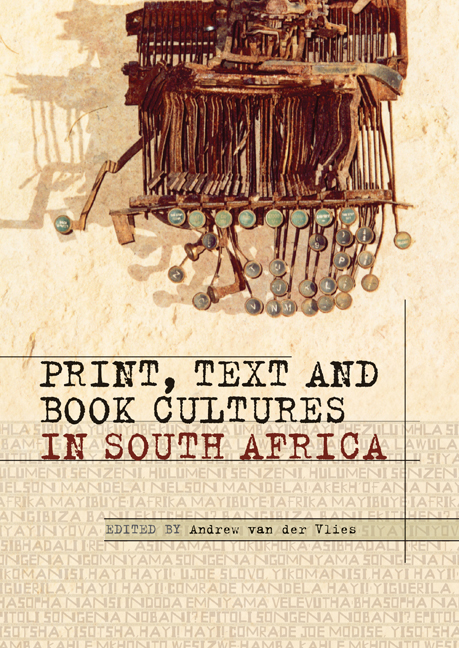Book contents
- Frontmatter
- Contents
- Acknowledgements
- Abbreviations and acronyms
- 1 Introductory
- 2 Print Cultures and Colonial Public Spheres
- 3 Local/Global: South African Writing and Global Imaginaries
- 4 Three Ways of Looking at Coetzee
- 5 Questions of the Archive and the Uses of Books
- 5.1 Colin Rae's Malaboch: The Power of the Book in the (Mis)Representation of Kgaluši Sekete Mmalebôhô
- 5.2 “Send Your Books on Active Service”: The Books for Troops Scheme during the Second World War, 1939–1945
- 5.3 From The Origin of Language to a Language of Origin: A Prologue to the Grey Collection
- 6 Orature, Image, Text
- 7 Ideological Exigencies and the Fates of Books
- 8 New Directions
- Contributors
- Index
5.2 “Send Your Books on Active Service”: The Books for Troops Scheme during the Second World War, 1939–1945
from 5 - Questions of the Archive and the Uses of Books
Published online by Cambridge University Press: 21 April 2018
- Frontmatter
- Contents
- Acknowledgements
- Abbreviations and acronyms
- 1 Introductory
- 2 Print Cultures and Colonial Public Spheres
- 3 Local/Global: South African Writing and Global Imaginaries
- 4 Three Ways of Looking at Coetzee
- 5 Questions of the Archive and the Uses of Books
- 5.1 Colin Rae's Malaboch: The Power of the Book in the (Mis)Representation of Kgaluši Sekete Mmalebôhô
- 5.2 “Send Your Books on Active Service”: The Books for Troops Scheme during the Second World War, 1939–1945
- 5.3 From The Origin of Language to a Language of Origin: A Prologue to the Grey Collection
- 6 Orature, Image, Text
- 7 Ideological Exigencies and the Fates of Books
- 8 New Directions
- Contributors
- Index
Summary
When General Jan Smuts's amendment to General Barry Hertzog's neutrality motion was carried by 80 votes to 67 on 4 September 1939, taking South Africa into the Second World War as Great Britain's ally, the country was at war. But the price of loyalty to Britain and its Commonwealth allies and stand against Nazi Germany was internal division among white South Africans. The United South African National Party (later the United Party), which had “fused” the National and South African Parties in 1934, now lost most of its Afrikaner support. The bulk of Afrikaners (including Hertzog) rejected Smuts's decision and regrouped under the banner of Daniel F. Malan's Purified National Party to become the Reunited National Party.
Internally, the war effort therefore aimed at English-Afrikaner reconciliation and at winning all South Africans to the Allied cause. Raising troops for the Union Defence Force (UDF) would, as a consequence, not be through coercion (i.e. conscription), but through volunteers only. Black South Africans were also allowed to join the UDF, but not as armed combatants. Some were enthusiastic about the war, others were indifferent, but most black volunteers grabbed the opportunity to learn new skills and earn a regular salary (Grundlingh 1986). The black or Non-European Army Services comprised three corps, namely, the Cape Corps that consisted of so-called “Cape coloureds”, the Indian and Malay Corps, and the Native Military Corps. They were used as boot makers, drivers, trench diggers, carpenters, cooks and stretcher bearers, and later also learned typing, clerical and other skills (Gleeson 1994, 112).
The war presented a unique opportunity to build a truly South Africanist loyalty with a captive audience of 123,131 blacks and 211,193 whites, of which about 60 per cent were Afrikaans speaking and 40 per cent were English speaking (South Africa 1946, 20). It offered the UDF and the South African Library Association (SALA) the chance to promote the democratic values of books, ideas and libraries. The vice-president of and leading spokesperson for the SALA, Douglas H. Varley, affirmed this role for books in a talk to the Association of University Women in 1941.
- Type
- Chapter
- Information
- Print, Text and Book Cultures in South Africa , pp. 240 - 251Publisher: Wits University PressPrint publication year: 2012



